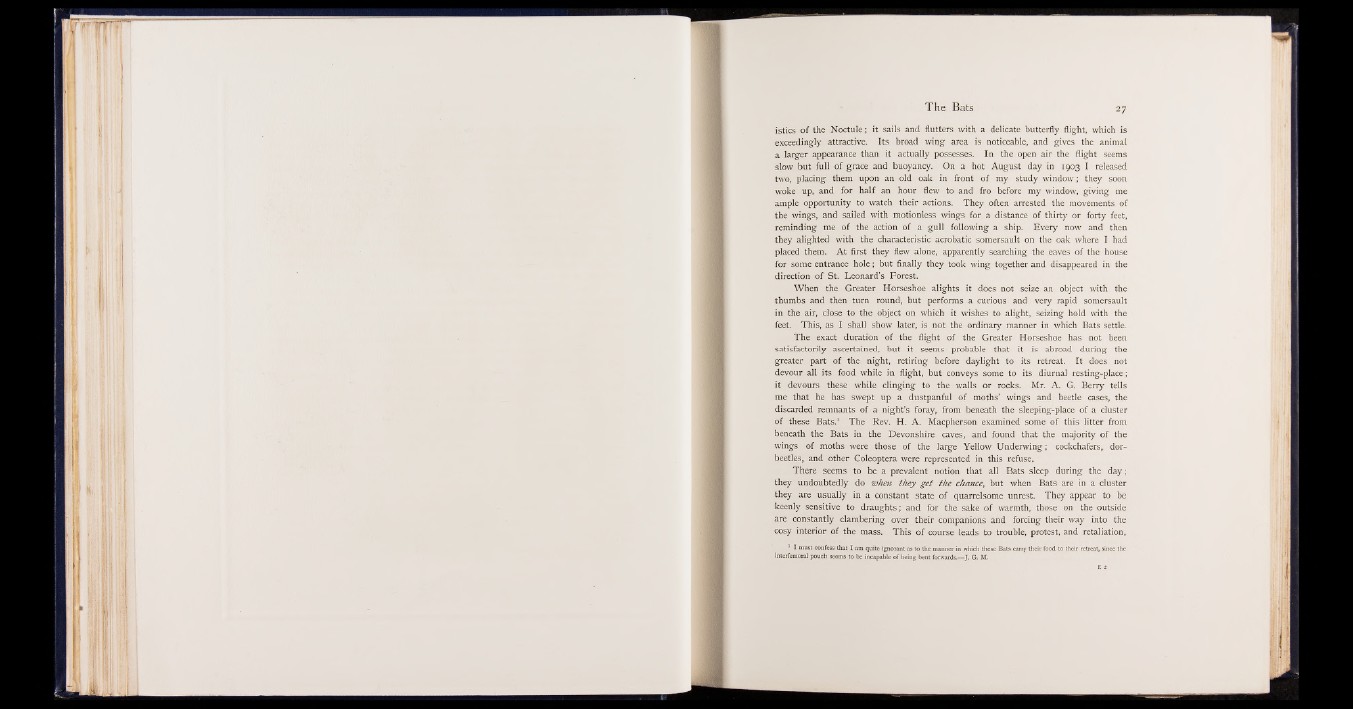
istics of the Noctule; it sails and flutters with a delicate butterfly flight, which is
exceedingly attractive. Its broad wing area is noticeable, and gives the animal
a larger appearance than it actually possesses. In the open air the flight seems
slow but full of grace and buoyancy. On a hot August day in 1903 I released
two, placing them upon an old oak in front of my study window; they soon
woke up, and for half an hour flew to and fro before my window, giving me
ample opportunity to watch their actions. They often arrested the movements of
the wings, and sailed with motionless wings for a distance of thirty or forty feet,
reminding me of the action of a gull following a ship. Every now and then
they alighted with the characteristic acrobatic somersault on the oak where I had
placed them. At first they flew alone, apparently searching the eaves of the house
for some entrance hole; but finally they took wing together and disappeared in the
direction of St. Leonard’s Forest.
When the Greater Horseshoe alights it does not seize an object with the
thumbs and then turn round, but performs a curious and very rapid somersault
in the air, close to the object on which it wishes to alight, seizing hold with the
feet. This, as I shall show later, is not the ordinary manner in which Bats settle.
The exact duration of the flight of the Greater Horseshoe has not been
satisfactorily ascertained, but it seems probable that it is abroad during the
greater part of the night, retiring before daylight to its retreat. It does not
devour all its food while in flight, but conveys some to its diurnal resting-place;
it devours these while clinging to the walls or rocks. Mr. A. G. Berry tells
me that he has swept up a dustpanful of moths’ wings and beetle cases, the
discarded remnants of a night’s foray, from beneath the sleeping-place of a cluster
of these Bats.1 The Rev. H. A. Macpherson examined some of this litter from
beneath the Bats in the Devonshire caves, and found that the majority of the
wings of moths were those of the large Yellow Underwing; cockchafers, dor-
beetles, and other Coleoptera were represented in this refuse.
There seems to be a prevalent notion that all Bats sleep during the day;
they undoubtedly do when they get the chance, but when Bats are in a cluster
they are usually in a constant state of quarrelsome unrest. They appear to be
keenly sensitive to draughts; and for the sake of warmth, those on the outside
are constantly clambering over their companions and forcing their way into the
cosy interior of the mass. This of course leads to trouble, protest, and retaliation,
I must confess that I am quite ignorant as to the manner in which these Bats carry their food to their retreat, since the
interfemoral pouch seems to be incapable of being bent forwards.— J. G. M.